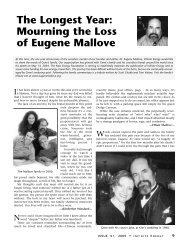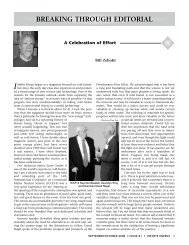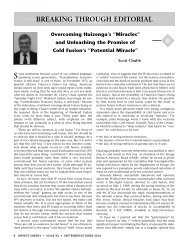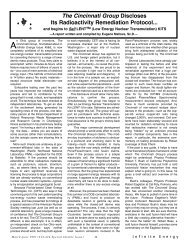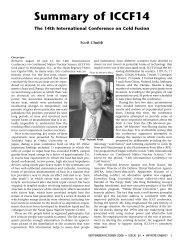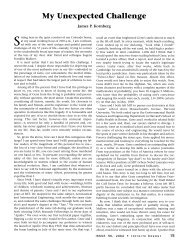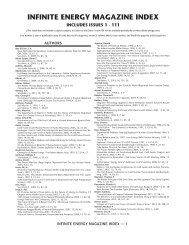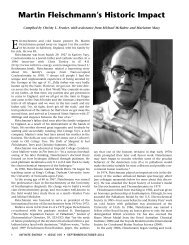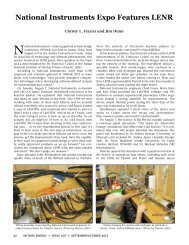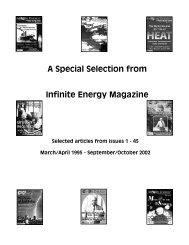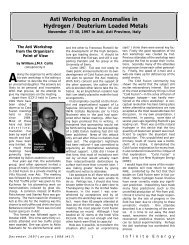MIT and Cold Fusion: A Special Report - Infinite Energy Magazine
MIT and Cold Fusion: A Special Report - Infinite Energy Magazine
MIT and Cold Fusion: A Special Report - Infinite Energy Magazine
You also want an ePaper? Increase the reach of your titles
YUMPU automatically turns print PDFs into web optimized ePapers that Google loves.
The result of this unsatisfactory situation has been that a<br />
healthy skepticism <strong>and</strong>, in some cases, distrust of the reported<br />
results has developed. We at <strong>MIT</strong> share this skepticism.<br />
At the risk of becoming too technical in my comments, I feel<br />
that I must be a bit more specific with regard to the source of this<br />
skepticism. As I mentioned earlier the major results, reported by<br />
the University of Utah group, are that there has been a generation<br />
of excess heat <strong>and</strong> the measurement of neutron radiation.<br />
By excess heat I mean that there has been a measurement of<br />
more energy produced than has been supplied to the system.<br />
From our st<strong>and</strong>point, the key point of verification is the detection<br />
of neutron radiation. From an engineering point of view,<br />
however, the importance of excess heat production is critical. On<br />
these two critical points we have found that the results reported<br />
in the few available published documents from the University of<br />
Utah are inconclusive or unclear. For example, with respect to<br />
the detection of neutrons, critical products of the fusion reaction,<br />
the reported results are confusing. They either do not agree with<br />
or are not presented completely enough to show that they are<br />
consistent with what one would expect from the emission of<br />
neutrons from the deuterium fusion reaction. Specifically, the γ-<br />
ray spectrum shown in the Fleischmann/Pons paper <strong>and</strong> attributed<br />
to neutron emission does not exhibit a shape <strong>and</strong> intensity<br />
that demonstrates the increase reported in the number of detected<br />
neutrons above normal background. Further, the reported<br />
rate of neutron emission <strong>and</strong> level of tritium production are consistent<br />
with natural background. The results have nevertheless<br />
been reported as “significant.” Those inconsistencies can only be<br />
resolved by a full disclosure of the details of the experimental<br />
measurements for examination by the scientific community.<br />
Until such time as this occurs we feel that the data is insufficient<br />
to demonstrate the presence of neutrons.<br />
As far as the issue of excess energy is concerned we are also<br />
faced with a confusing situation. While the presence of excess<br />
energy is documented in the Journal of Analytical Electrochemistry<br />
paper, the method by which this excess energy was determined<br />
is not clear. With metals, such as palladium, which act as<br />
hydrogen storage media <strong>and</strong> at the same time as catalysts for<br />
many chemical reactions, both situations which can result in<br />
discontinuous chemical energy releases, it is critical that a total<br />
energy balance over time be done. To us it is not clear that this<br />
has been the case. Until this issue is clarified we are unable to<br />
make a judgement concerning the excess energy issue.<br />
In conclusion, I feel that it is safe to say that the scientific<br />
community is (1) excited about the possibility of a significant<br />
advance in the area of fusion energy research, (2) but is, at the<br />
same time, skeptical of results that have not been verified to this<br />
point <strong>and</strong> (3) is very frustrated at the methods by which the discovery<br />
has been h<strong>and</strong>led both in the scientific <strong>and</strong> non-scientific<br />
community. Thank you.<br />
PROFESSOR RONALD GEORGE BALLINGER<br />
Professor Ballinger is an Associate Professor at the Massachusetts Institute<br />
of Technology with a joint appointment in the Departments of<br />
Nuclear Engineering <strong>and</strong> Materials Science & Engineering. Professor<br />
Ballinger's areas of specialization are as follows: (1) Environmental<br />
effects on material behavior, (2) Physical metallurgical <strong>and</strong> electrochemical<br />
aspects of environmentally assisted cracking in aqueous systems,<br />
(3) Stress corrosion cracking <strong>and</strong> hydrogen embrittlement in Light<br />
Water Reactor systems, (4) The effect of radiation on aqueous chemistry<br />
<strong>and</strong> stress corrosion cracking, (5) Experimental fracture mechanics techniques<br />
<strong>and</strong> analytical methodology, <strong>and</strong> (6) Materials development for<br />
cryogenic applications. Professor Ballinger is the author of several<br />
papers in the above areas <strong>and</strong> is a member of several professional societies<br />
including the National Association of Corrosion Engineers, The<br />
American Society for Metals, The Electrochemical Society, The American<br />
Nuclear Society, <strong>and</strong> the American Society for Testing <strong>and</strong> Materials.<br />
Professor Ballinger is a member of the International Cyclic Crack<br />
Growth Review Group <strong>and</strong> the International Cooperative Working<br />
Group in Irradiation Assisted Stress Corrosion Cracking.<br />
<strong>MIT</strong> <strong>Cold</strong> <strong>Fusion</strong> Group<br />
Plasma <strong>Fusion</strong> Center<br />
Professor Ronald R. Parker<br />
Director, Plasma <strong>Fusion</strong> Center<br />
Plasma Physics/<strong>Fusion</strong> Research<br />
Dr. Xing Chen<br />
Postdoctoral Associate<br />
Radiation Detection<br />
Dr. Catherine Fiore<br />
Research Scientist<br />
Radiation Detection<br />
Dr. Marcel Gaudreau<br />
Research Engineer<br />
<strong>Fusion</strong> Engineering<br />
Dr. David Gwinn<br />
Research Engineer<br />
Instrumentation/Design<br />
Dr. Paul S. Linsay<br />
Principal Research Scientist<br />
Radiation Physics<br />
Dr. Stanley Luckhardt<br />
Principal Research Scientist<br />
Plasma Physics<br />
Dr. Richard Petrasso<br />
Research Scientist<br />
X-<strong>and</strong> γ-ray Spectroscopist<br />
Mr. Kevin Wenzel<br />
Graduate Student<br />
Radiation Detection<br />
Dept. of Nuclear Engineering<br />
<strong>and</strong> Dept. of Materials Science<br />
<strong>and</strong> Engineering<br />
Professor Ronald G. Ballinger<br />
Associate Professor<br />
Physical Metallurgy <strong>and</strong> Electrochemistry<br />
Dr. Il Soon Hwang<br />
Research Scientist<br />
Physical Metallurgy/Electrochemistry<br />
Dr. Alan Turnbull<br />
Visiting Scientist (National Physical<br />
Laboratory, UK)<br />
Electrochemistry/Surface Science<br />
Martin Morra<br />
Graduate Student<br />
Physical Metallurgy<br />
Mr. Frank Wong<br />
Graduate Student<br />
Mechanics/Instrumentation<br />
Department of Chemistry<br />
Professor Mark Wrighton<br />
Head, Department of Chemistry<br />
Chemistry/Electrochemistry<br />
Dr. Richard Crooks<br />
Postdoctoral Associate<br />
Electrochemistry<br />
Mr. Vincenzo Cammarata<br />
Graduate Student<br />
Chemistry/Electrochemistry<br />
Mr. Martin Schloh<br />
Graduate Student<br />
Chemistry/Electrochemistry<br />
“Words to Eat”<br />
Mr. David Albagli<br />
Graduate Student<br />
Chemistry/Electrochemistry<br />
<strong>MIT</strong> Professor Ronald George Ballinger may hold the alltime<br />
record for making a foolish statement against cold fusion.<br />
He wrote in 1991: “It would not matter to me if a thous<strong>and</strong><br />
other investigations were to subsequently perform experiments<br />
that see excess heat. These results may all be correct,<br />
but it would be an insult to these investigators to connect them<br />
with Pons <strong>and</strong> Fleischmann.”<br />
These words of “wisdom” appeared in the Gordon Institute<br />
News, March/April 1991. Apart from their unrepentant mean<br />
spirit, they are internally inconsistent. If in his hypothetical the<br />
remarkable discovery of Fleischmann <strong>and</strong> Pons were to be<br />
validated, why would the scientists not be due praise? Is<br />
Ballinger’s sense of righteous indignation about Fleischmann<br />
<strong>and</strong> Pons so pronounced that he could not grant them credit—ever?<br />
One would think that scientific ethics alone would<br />
m<strong>and</strong>ate that these “thous<strong>and</strong> other investigations” should be<br />
tied directly to those who inspired them!<br />
Ballinger wrote in the same venue: “Putting the ‘<strong>Cold</strong><br />
<strong>Fusion</strong>’ issue on the same page with Wien, Rayleigh-Jeans,<br />
Davison-Germer, Einstein, <strong>and</strong> Planck is analogous to comparing<br />
a Dick Tracy comic book story with the Bible.” The facts<br />
about this moralizing hypocrite, Prof. Ballinger, are even more<br />
amazing when one learns that Ballinger subsequently personally<br />
sought funding support from Dr. Thomas O. Passell at the<br />
Electric Power Research Institute (EPRI) to carry out materials<br />
science projects related to cold fusion!<br />
23 <strong>Infinite</strong> <strong>Energy</strong> • ISSUE 24, 1999 • <strong>MIT</strong> <strong>Special</strong> <strong>Report</strong>



